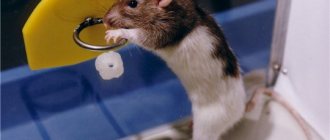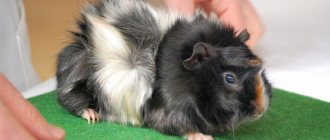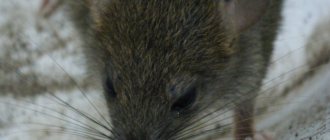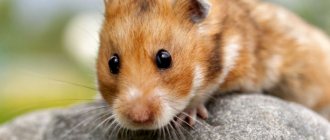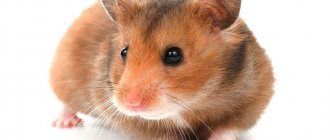These small, furry rodents are one of the most popular pets.
flickr/pyza
Hamsters have won a strong place in the homes and hearts of caring owners thanks to their unpretentiousness, friendliness and intelligence. But despite all their advantages and popularity, the decision to place a new furry pet in your home must be approached with all responsibility.
To buy or not to buy?
The first thing you need to pay attention to is that family members are not allergic to animal hair or bedding fillers. Second, but no less important, is the choice of location for the cage of the future pet. Hamsters equally do not like drafts, too warm or cold air, and dampness. They do not belong in a smoky room, on the floor or windowsill. It is important to remember that these are living beings and they have the right to demand that they be treated with dignity.
flickr/pyza
Other indisputable advantages of keeping hamsters include their low cost and ease of care, which does not require special skills. The small amount of food a hamster needs for a full life will not affect the family budget in any way, and its cage will not take up much space in the apartment.
Benefits of keeping a hamster at home
Buying hamsters for pets has several advantages.
Among them:
- Quick adaptation of the pet to the new environment.
- Easy to care for.
- Strong immune system and resistance to common diseases.
- A normal existence alone.
In addition, a small animal improves the mood of the people living in the house, because his behavior always evokes positive emotions. If you want to breed young individuals, it is enough to buy a specimen of the opposite sex. Watching a male courtship and raising offspring is quite interesting.
The cost of the rodent and accessories for its maintenance is low. Buying a hamster is much cheaper than getting a cat or dog.
The pet is sociable, so it quickly establishes contact with the owner and other family members.
Cell selection
A cage with vertical or horizontal bars is the most suitable and comfortable home for a hamster. Its size depends on the breed of hamster. For dwarf hamsters - Djungarian and Roborovsky - the height and width are approximately 30 cm, length - 50 cm. For golden or Syrian hamsters, it is better to choose a larger cage - 40 cm wide and high, about 60 cm long.
Unlike Syrian hamsters, Djungarian and Roborovian hamsters are indifferent to climbing rods and other acrobatic tricks, so plastic cages (dunes) are quite suitable for them. Under no circumstances should hamsters be placed in tall and narrow aquariums - bacteria multiply very quickly here, there is high humidity and there is almost no access to fresh air.
flickr/pyza
What is required for maintenance
Proper keeping of a hamster at home can not only improve the well-being and health of the small rodent, but also prolong its life. If you create all the conditions for a comfortable existence, the hamster will live a long and happy life without stress.
To keep a pet hamster you need:
- cell;
- house;
- toys;
- feeders 2 pieces;
- drinking bowl;
- running wheel, ball, maze, playground or tunnel.
When choosing a cage, you need to take into account the number and type of hamsters you plan to keep. It is not recommended to house several hamsters in one cage, but in practice it turns out differently. The minimum cage size for one rodent is 60 by 40 cm. It is important that the bars of the cage are positioned horizontally, since hamsters are very active and love to climb the walls of the cage.
The cage must be selected specifically for small rodents. Since the distance between the rods plays an important role. If you are planning to get dwarf hamsters, choose a distance so that a small hamster cannot fit between them.
To keep hamsters, they often buy a cage. But you can use an aquarium. It is important that the size of the aquarium also corresponds to the minimum size of 60 by 40 cm per pet, and the number of hamsters living.
Under no circumstances should hamsters be kept in cardboard boxes or plastic containers. Hamsters are rodents; their teeth grow throughout their lives. They will instantly chew up a dwelling made of fragile material and run away. Finding and catching an escaped hamster is not an easy task. But besides this, he can also get poisoned.
Cage interior
To make your pet feel happy and healthy, he needs to not only be fed, but also entertained. Golden hamsters cannot do without climbing devices - various decorative branches, tubes, labyrinths, obstacles that create several tiers in the cage at once. Here, it is necessary to have a wheel with cross bars; it can be attached to the wall or installed on the floor of the cage.
Medium-sized sawdust, compressed or mixed with shavings, as well as fine sifted sand for dwarf rocks are most often used as bedding. All types of textile or paper bedding, including newspapers, cotton wool, and rags, are strictly excluded.
An important place in a hamster’s home is a house for sleeping and resting; here he can store valuable things. The house should be quite spacious and comfortable, preferably attached to the wall. Its design should provide easy access for washing and ventilation.
flickr/pyza
Having bought a cage and placed a hamster in it, immediately install a toilet in it with a special filler that absorbs odor and moisture. You need to train your hamster to use the litter tray from an early age, otherwise retraining it will be very difficult and often impossible. The filler must be replaced once a week.
You can purchase a feeder in a store or make it yourself, taking into account the size of your pet. On average, the size of the feeder varies from three to ten centimeters, with a height of about one and a half centimeters.
You can use a small container - about 50 milliliters - as a drinking bowl. This volume will fully satisfy the hamster’s daily need for water. The water in the drinking bowl should be changed daily, and it is also very important to ensure that there is no wet sawdust around the container.
flickr/pyza
The nuances of caring for newborn hamsters
When caring for cubs, it is important not to touch them with your hands. This rule applies to both dwarf breeds and other types of rodents. Otherwise, the female will smell a foreign odor and refuse to feed the offspring.
Therefore, zoologists recommend leaving the young with their mother for several days and only replenishing food and water supplies.
After 5-7 days from the moment of birth, the female and her children are transplanted into a new box, and the cage is thoroughly cleaned and the bedding is replaced. In the future, such processing is performed once every 2 days. After the appearance of fur, pets can be introduced to complementary foods.
We buy only healthy hamsters
When choosing a hamster, it is very important to make sure that your future pet is healthy. A visual inspection and observation of his behavior will be enough to make sure that everything is fine with him. So, a hamster is healthy if:
- He has a shiny, thick coat with no signs of hair loss. Scars spoil the appearance of the animal, but do not indicate its poor health.
- his eyes are clear, clean around and shiny.
- There is no nasal discharge, the nose itself is healthy and clean.
- the fur around the anus is clean, without signs of diarrhea or inflammation.
A hamster that has just been woken up should not show excessive anxiety or, conversely, apathy. Both options indicate a stressful state of the animal, which can subsequently result in high vulnerability and disease. Only Roborovsky's hamsters are characterized by increased fussiness in any circumstances.
flickr/pyza
Treatment
You can relax here. You won't have to vaccinate your hamster; you'll save your hard-earned money on vaccinations and veterinarian fees. Firstly, these rodents rarely get rabies. Secondly, vaccinating an animal that lives only two or three years is simply not profitable and pointless. Virus-resistant antibodies simply do not have time to be developed in the hamster’s body during its short life.
But you cannot do without treatment completely. The rodent may develop parasites - worms and fleas. To make your animal feel comfortable, you will have to buy a special powder and treat it. This powder costs about 100 rubles, and it won’t last a hamster’s entire life.
Of course, rodents sometimes get more seriously ill. But in each specific case, you need to consult a veterinarian, who will prescribe the appropriate treatment, the cost of which can be found out directly at the veterinary clinic.
Getting used to the new home
In order for your new guest to quickly get used to his new conditions, give him a few days to leisurely explore his home. Once the initial stress has passed, innate curiosity will take over and the hamster will begin to explore its cage with interest, feeling increasingly confident.
If there is a need to take the animal, for example, to the veterinarian, it is not at all necessary to take the entire cage with you - it is enough to purchase a small carrier for rodents. Subsequently, it will come in handy during general cleaning of the cage. Alternatively, a well-ventilated cardboard box can be used.
flickr/pyza
Nutrition
The hamster, of course, does not eat much, and a package of special food will last you for a month. Don’t go cheap, cereals alone (90 rubles per package) are not enough for him - buy food that also contains nuts and dried fruits (230-250 rubles in Kemerovo pet stores).
In any pet store, in addition to regular food, you can buy hamster treats - cookies or various kinds of bars. But this is not necessary - “live” vitamins are no worse. We don’t include this in our expenses: after all, we buy fruits and vegetables for ourselves, which means that the hamster will also get it – how much does he need?
see also
How to handle a hamster?
Gaining your hamster's trust will take patience and some time. However, all the efforts spent on this will pay off in full - communication with your pet will bring you only joy. What are the do's and don'ts when handling hamsters?
It is forbidden:
- make sudden movements or wave your arms near the hamster;
- pick up a hamster that has just woken up or is sleeping;
- drive into a corner or cover with palms;
- scream loudly near the cage;
- leave it on high surfaces - it does not distinguish distances and will definitely fall down;
- grab by the scruff of the neck with a rough movement.
Can:
- talk to the animal in a soft, calm voice;
- when picking him up, do it slowly and carefully, clasping him under the front paws;
- touch the hamster only with clean hands and give him the opportunity to sniff your hand first - this way he will quickly get used to your smell;
- Give him a chance to calm down if he is scared.
flickr/pyza
Feeding
The diet of hamsters provides for 3-4 meals a day during the day, and the second feeding of the day should be as high in calories as possible. The basic component in the diet of rodents is ready-made grain food, which can be purchased at a pet store.
In addition to the main dry food, the rodent's menu should contain food with a protein component and juicy components. When creating a diet for a hamster, it is important to consider that the following list of foods is strictly prohibited for rodents:
- Almonds, acorns, Brazil nuts, cherry and apricot pits, watermelon seeds.
- White and black bread, breakfast cereals and sweet muesli.
- Beans and bean sprouts.
- Dried fruits and candied fruits.
- Vegetables such as cabbage, potatoes, garlic and onions.
- Coniferous branches.
- Spicy herbs, wild garlic and spices.
- Any exotic fruits.
- Sausages, sausages.
- Cheese, sour cream and butter.
Sausages
Animal protein should be given to the hamster no more than 3 times a week; allowed foods include boiled chicken, eggs, natural low-fat yogurt, and boiled low-fat fish.
What to do if bitten by a hamster?
Hamsters are harmless, but very sensitive and timid creatures. Therefore, sometimes there is a risk of being bitten, but not out of malice, but for the purpose of self-defense. Additionally, if your hand smells like food, your hamster may simply mistake it for a tasty treat. What to do if you are bitten?
Firstly, remain calm and not punish the animal - he did not do it out of malice. Carefully place it in the cage and treat the bite site with brilliant green, alcohol or hydrogen peroxide, and apply a band-aid. If your hamster is healthy, then there will be no dangerous consequences from the bite.
flickr/pyza
Varieties
According to the latest information, there are 19 species of hamsters in the world, which belong to 7 genera. Let's consider information about those species that are suitable for keeping in an apartment.
Djungarian hamster
This is a dwarf hairy-footed species. Such hamsters are often kept at home, as they are clean and non-aggressive towards people. Their body length rarely exceeds 10 cm.
Dzungariki weigh 30-60 grams. This species lives in dry steppe regions and semi-deserts in western Siberia, parts of China and Kazakhstan. The natural color of the rodent is gray-brown. There is a dark stripe on the back that runs along the spine, and a dark spot on the crown.
Syrian hamster
The rodent lives in Syria and Turkey. The hamster grows to a size of about 13 cm, weighs approximately 125 g. The length of the tail is 1.5 cm.
This is a peaceful and sociable animal with a golden coat.
Campbell's hamster
This rodent has an external resemblance to the dzhungarik, but some characteristics differ. Body dimensions are from 7.5 to 10 cm, the weight of the hamster does not exceed 60 g, the tail length is up to 1.4 cm. The paws are shaggy.
The natural color of the rodent is gray-brown. The fur on the belly is gray at the base and white at the tips. There is a thin dark stripe on the back that starts from the neck and ends at the base of the tail.
Roborovsky's hamster
This is one of the smallest representatives of the family. Its weight is 30 g, and its body length is no more than 5 cm. The color of the rodent on the back and head is sandy, the fur on the belly is white. The fur above the eyes is bleached. This hamster is not often found at home.
This is one of the few rodents that gets along well in a group.
Other types of hamsters:
- common hamster;
- Transcaucasian;
- Newton's hamster;
- Mongolian;
- Eversman's hamster;
- Kansky;
- short-tailed;
- rat-like;
- Tibetan;
- long-tailed;
- hamster Radde et al.
Attention! The largest representative of the family lives in the forest-steppes of Europe. This is an ordinary hamster that weighs from 400 to 700 g. Its body grows up to 34 cm in length.
What and how to feed hamsters?
The main food of hamsters is solid grains such as wheat, oats, and millet. They also love to nibble on seeds and nuts, but these delicacies cannot be their main food; it is better to leave them as dessert. Hamsters satisfy their need for fluids and vitamins with juicy vegetables and fruits - apples, carrots, pears, celery, cucumbers, beets, and corn. Garlic, onions, citrus fruits and cabbage should be excluded from their diet. Sometimes you can pamper your hamster with sweet berries in small quantities - strawberries, raspberries, grapes.
Feeding occurs twice a day - morning and evening. To determine the portion size and taste preferences of your pet, just watch him for a while. And don’t forget to give him a drinking bowl with clean water every day.
flickr/pyza
Housing issue
Before buying a hamster, you need to prepare a place for its future keeping. Purchasing glass jars or aquariums for these purposes is a common mistake. Such housing will not be comfortable for a rodent, and also interferes with normal air circulation.
The best option for living a furry pet is a cage, the dimensions of which will be at least 50 cm long and 30 cm wide for one individual. The rods must be positioned horizontally with a minimum distance between them.
Eating food with a funny hamster
The cage must be equipped with the following accessories:
- Feeder. Preference should be given to ceramic options, but you can also opt for plastic models. It is advisable that in one cage there are two feeders at once: one for dry food, the second for wet food.
- Drinking bowl. It is a special design for rodents. Hamsters easily adapt to hanging drinkers with a special rod, which allows them to always have access to clean water. There is no point in pouring water into a bowl, since the hamster will quickly contaminate it with filler and pieces of food during its vigorous activity.
- Filler. The use of sawdust or special wood filler is a prerequisite for comfortable keeping a hamster. The granules can easily cope with unpleasant odors by absorbing animal urine.
- Mineral stone. Necessary for sharpening cutters.
- Running wheel. This accessory is necessary for hamsters due to their increased activity. The surface of the treadmill must be solid to avoid injury to the animal.
It is necessary to change the litter in the cage regularly, since it is useless to train a hamster to go to the toilet in one place in the tray. Constantly replacing the bedding will avoid the appearance of an unpleasant odor and help keep the animal’s home clean.
It is advisable to locate the cage away from drafts, beds and children’s play areas. It is important to determine once and for all a place for the animal to live, since hamsters tolerate any changes very painfully.
If desired, you can equip the animal’s cage with a wooden house, which will serve as a shelter for it from the outside world and become a place to sleep.
Water treatments and nail trimming
Hamsters do not like to bathe, so water procedures should be used only when necessary. For bathing, a special shampoo for rodents is best, after which the fur should be blotted with a soft towel. If the room is cool and you are worried that it will freeze, you can lightly dry it with a hairdryer using a gentle stream of warm air.
Overgrown claws are cut off with great care using a special nail clipper or nail clippers.
flickr/pyza
Useful tips and advice for beginners
Proper maintenance of a hamster comes down to following these recommendations:
- The hamster should be kept alone in a separate enclosure.
- The pet should be isolated from noise and stressful situations.
- The air in the room where the pet lives should not be allowed to become hypothermic.
- You cannot take the animal outside and let it run around on the grass.
- You cannot use food from the table to feed your pet. Fatty, sweet, spicy and sour foods have a detrimental effect on a weak digestive system.
Reproduction of hamsters
Hamsters are allowed to mate after both partners reach three months of age.
On average, the duration of pregnancy in hamsters is from two and a half to three weeks.
For about three more weeks, the babies born will feed on their mother's milk. During this period, it is advisable to add a small amount of protein to the female’s diet - a hard-boiled egg, a piece of cheese or boiled chicken. Before giving birth, it is better to move the cage with the expectant mother to a quiet place with low lighting.
If the female is young and has become a mother for the first time, she may abandon her cubs and even eat them. Unfortunately, if this happened before the babies reached at least ten days of age, then it will not be possible to save them. After 3.5 - 4 weeks, the cubs are separated, being housed in separate cages. They should not be allowed to stay with their mother for more than five weeks.
flickr/pyza
Newborn hamsters are hairless, deaf and blind. For the first few days, their main food is mother's milk, then they gradually switch to small grains. At the end of the first week, their fur begins to grow, and at the end of the second, their eyes open. Within a month, they will be completely accustomed to the world around them.
After the offspring are born, the male should not be in the same cage with the female - he will not harm the babies and even help in caring for them, but it is very likely that the female will become pregnant again, and this can be dangerous for her health.
Description of the animal
Hamsters are rodents that belong to the large family Hamsters. Depending on size, color and temperament, it is divided into types.
Not all varieties are suitable as pets, but only a few - Djungarian, Syrian, Roborovsky and Campbell hamsters.
Appearance
The Hamster family includes rodents with a dense build, short limbs and small ears. The body size of a hamster varies between 5-34 cm. The animals have a tail. Its length varies among different species and ranges from 0.7 to 10 cm.
The structure of a hamster is amazing. Take the cheek pouches, for example. All representatives of this family have them. These are capacious cavities in the mouth, which are formed by muscle fibers and are used to transport food supplies. To extract food, the rodent has to forcefully push it out with its paws.
The rodent has 16 teeth - 4 long arched incisors and 6 molars on each jaw. There are no fangs. The incisors grow throughout life, so the hamster must constantly grind them down. Most species have 4 fingers on their limbs, the fifth is underdeveloped. Djungarian and Syrian hamsters have all 5 toes.
The rodent's body is covered with thick short or long hair. The fur on the back can be painted in any shades of gray and brown. The fur on the chest and belly is black, white or grey. Representatives of some species have a dark longitudinal stripe on their backs.
Character and habits
The hamster is a nocturnal animal. In the wild, it spends most of the day in a burrow underground. When dusk falls, he climbs to the surface and goes in search of provisions. During the night, the rodent moves vast distances.
In the world of hamsters, it is not customary to live in packs or families. Rodents prefer solitude and zealously defend their territory from those who encroach on it. Individuals of different sexes unite only for mating. Rodents dig complex burrows with their front paws. The animal's home has several zones that resemble rooms. One is reserved for storing provisions, the other for nesting and waste. Hamsters do not hibernate.
Interesting fact! Due to lack of food or severe cold weather, rodents fall into torpor. This is a condition in which vital processes slow down and the hamster's body temperature decreases. In this case, the animal appears dead, but its pulse can be heard and breathing continues.
At home, the hamster maintains the lifestyle and habits that are characteristic of rodents in their natural habitat. The animal is awake at night and sleeps in its house during the day.
Such animals are often kept for children. Hamsters are highly tamed and make cute, fun pets to watch.
Health and life expectancy
Under natural conditions, rodents live for about 1 year. The life of hamsters in the wild is full of dangers. They risk being attacked by predators every day. Defenseless animals have many natural enemies - snakes, birds and wild animals - foxes, lynxes, tigers.
In addition, rodents die from diseases. Pet hamsters can live 2-3 years.
With good care, rodents rarely get sick, but sometimes they are bothered by health problems. At home, they often get injured when falling from a height. Your hamster may also have a cold, constipation or diarrhea, or conjunctivitis. Some rodents suffer from parasitic infections and tumors.
Hamster diseases
In a hamster’s body, any process proceeds much faster than in a human body, and this also applies to diseases. Therefore, if your pet shows signs of an infectious disease, it must be shown to a veterinarian as quickly as possible. In view of this, you need to find out in advance where the nearest veterinarian who can treat these animals is located.
First of all, attention should be paid to the glands with which hamsters mark their territory.
Hamsters also often suffer from broken limbs. If the fracture is closed, then the legs heal well without special treatment, but if the fracture is open, then the animal must be shown to a veterinarian. In case of any fracture, the animal must be limited in movement by removing stairs, floors, pipes and fighting wheels from the cage.
If the ambient temperature drops below 10-12 degrees, the hamster may hibernate. To bring the hamster out of this state, you need to warm it in your palms.
Caring for hamsters: what are the features of caring for a pet rodent?
Closer to two years of age, the hamster begins to show the first signs of aging. Unfortunately, this phenomenon cannot be treated and the only thing the owner can do is to alleviate the unpleasant phenomena associated with it for the animal.
How to clean a hamster
Caring for hamster fur.
Almost all hamsters have short fur, but despite this, they still need brushing. If the hamster has long hair, then you need to brush it every day, otherwise its fur will not be silky or neat. To make caring for your animal easier, you can purchase a special powder for cleaning hamsters. This powder will help maintain the health and appearance of your pet, and will also be good protection against fleas. You can use a regular toothbrush for cleaning.
What breed of hamsters is best to give to children?
Different breeds of hamsters differ not only in body length and coat color, but also in character. In order for a child to find a truly good and affectionate friend, parents should choose an animal not only with a cute appearance, but also with a cheerful and sociable disposition. What kind of hamster is best to get for keeping in a children's room? The most popular are Syrian and Djungarian rodents.
Syrian hamsters
Large, kind and flexible animals, not afraid of human hands. The optimal choice for children. Rodents of this breed do not show aggression, quickly get used to their owner, and can be taught to respond to a nickname. They are clean, love to wash themselves and tidy up their cage, and live a long time compared to dwarf hamsters, up to four years. The coat color of Syrians can be very different: golden, white, yellow, brown, gray, black.
Djungarian hamsters
If you choose who is better - a Syrian or a Djungarian hamster, then the Syrian will have the advantage. Djungarians are calm and affectionate dwarf rodents. They are bought for children if the dimensions of the home do not allow them to keep a large cage for a large animal of the Syrian breed. Djungarian hamsters are timid, and when they sense danger, they can jump out of your hands and seriously injure themselves, so they need to be handled carefully. Also, when a tiny pet escapes from its cage and hides under furniture, it is not easy to find it. So, parents who are thinking about which hamster to choose have no doubt that Djungarians and Syrians are the best option for their child.
Age
One of the most important indicators when choosing a hamster. The older the hamster, the less time it will live with its owner. Also, an adult is more difficult to tame. Adult hamsters take longer to get used to their new place of residence and take a long time to adapt to new conditions.
The optimal age of a hamster is 1-2 months. If you take a hamster that is less than 1 month old, there is a high probability that it will die.

